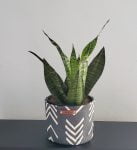Sansevieria, better known as snake plants or mother-in-law plant, is one of the easiest house plants to start with. Not only are they beautiful, they are also very easy to care for. Unlike some of my other fussier indoor plants, these plants require the least amount of attention. Putting a few of these plants in your bedroom will not only be decorative, but will also benefit your health.
Benefits of Snake Plants
Like most house plants, snake plants are great to place around your house, in particular, in your bedroom. Personally, I have 4 of them in my bedroom. Here are 5 benefits of snake plants that you may not have known.
- Air purification: Snake plants are known for their ability to purify the air by removing toxins and pollutants such as formaldehyde, benzene, and trichloroethylene. This makes them great for improving indoor air quality and creating a healthier living environment.
- Low maintenance: Snake plants are very easy to care for and require minimal watering and sunlight, making them an ideal plant for those who are new to gardening or have a busy lifestyle.
- Aesthetically pleasing: Snake plants have a unique and attractive appearance with long, pointed leaves that grow upright. They come in a variety of colors and patterns, making them a great addition to any home décor.
- Health benefits: Snake plants have been found to have several health benefits, including reducing stress levels and improving sleep quality. They also release oxygen at night, which can help improve the air quality in your bedroom and lead to better sleep.
- Pet-friendly: Unlike many other houseplants, snake plants are non-toxic to cats and dogs, making them a safe choice for pet owners.
Snake Plant Varieties
- Sansevieria trifasciata: Also known as the mother-in-law’s tongue, this is the most common variety of snake plant. It has tall, upright leaves with yellow edges and green stripes.
- Sansevieria cylindrica: This variety of snake plant has cylindrical leaves that grow upwards, rather than the flat leaves of other varieties. It is also known as the African spear plant.
- Sansevieria laurentii: This variety has long, pointed leaves with yellow edges and green stripes. It is similar to the mother-in-law’s tongue, but the leaves are shorter and wider.
- Sansevieria zeylanica: This variety has dark green leaves with light green stripes. It is sometimes called the bowstring hemp plant.
- Sansevieria fernwood: This variety has long, narrow leaves that grow upright in a fan shape. It is sometimes called the fernwood snake plant.
- Sansevieria moonshine: This variety has silvery green leaves that are wider and shorter than other varieties. It is a newer cultivar that has become popular in recent years.
How to Care for Snake Plants
Overall, these plants are very easy to care for. First, ensure they have the proper soil. These plants will rot if watered too frequently. Any fast draining soil should be fine. For my snake plants, I do a mix of cactus soil and regular potting soil. In addition, I also have my plants in a pot that has adequate drainage with a saucer. I water my plants on average, once a month, while making sure that I never soak the soil completely, rather just watering enough for the soil to dampen.
They do not require a ton of light and therefore do well in poorly lit rooms. I have all of my snake plants away from the window. However, they all receive 4-5 hours of indirect sunlight. Basically, this is how I care for my snake plants. They all seem to love the environment that I have created for them.
Planting a variety of plants, flowers, and trees is not only great for your wellbeing, it is great for the environment. If you have any tips for raising these beauties, I would love to hear them. Please share any tips in the comments.
F.A.Q.’s
- How often should I water my snake plant?
Water your indoor snake plant once a month in the winter months, and only twice a month in the summer months. Outdoor plants may need more water depending on the amount of sun they receive throughout the day.
2. How do I propagate a snake plant?
Snip off a piece of the leaf close to the soil. Place the cutting in water covering 25% of the leaf. Change the water weekly, being sure to keep the plant in indirect sunlight. Once the roots grow, place the cutting in soil.
3. How can I tell if my snake plant is getting too much or too little light?
Snake plants can thrive well in low light areas. If your plant is receiving too much sun, the leaves will burn and turn brown.
4. What should I do if my snake plant is infested with pests?
If your snake plant is infested with pest, change the soil immediately. Clean the roots with water, ensuring the pest are removed. Optionally, there are products available with neem oil that can be sprayed on the plants to kill of the pest.






One thought on “Snake Plant Care Guide For Beginners”